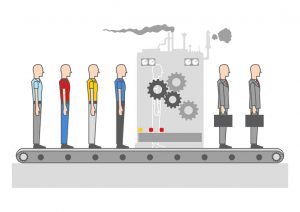
Many technology initiatives designed to bring about change within organizations do not work properly when you compare the performance obtained with the performance expected.
Download this user experience template and make sure you know what your team needs
In most cases, this failure occurs because, despite new project management systems having been implemented, it has not been possible to truly change the operational fabric of the company.
The premise mistakenly assumes "our team will use new methods, new technologies, processes and work systems, as they are designed or told to use them."
The reality is very different, the fact that the corporate structures decide to adopt a new methodology of work does not mean that they are implemented automatically in the practical terrain of each day. In order for the application to be carried out correctly, there must be a teaching process and control systems that guarantee this.
Without this, the result is that despite acting according to the new methodologies, in the background they are still acting according to the old systems, using the new methodologies as a patch to save appearances. In this way, duplications are generated that not only do not increase productivity, but can even reduce it.
In addition, in these situations where the users of the new tool are not used to defining exactly the linkage between talent and technology, it is usual to allow for the practice known as IT shadowing. When an employee or team faces a challenge in their work for which there is no technological solution, they will seek solutions in the market and will try to adopt them spontaneously. In large organizations, this leads to a clear erosion in workflows and a lack of visibility over the corporate technology portfolio.
Therefore, when evaluating the results obtained by the company after the application of the new working methodologies, it is possible that the results originally expected will not be obtained. However, it is not necessarily because the new technologies or working methods are not efficient, but that they have not been properly implemented. Often this implies a lack of attention to the specific needs of employees; to their ways of using technology; and a lack of interest in identifying the causes of friction.
Organizational change management: the missing piece of the puzzle
Organizational change management is the missing piece that allows for change management to be properly implemented in a company. It is responsible for managing the changes in the structure of a company, both at the role distribution level and in the most cultural and personal aspect, to successfully implement a new working methodology.
Expressed in another way, organizational change management takes care of the more personal and human facet of change, which is usually implemented in a practical way through internal projects.
With all of this, it aims to focus on what has been proven to be the main cause of failure in the implementation of new methodologies. These are not technological problems or software failures, but the human factor: motivation, expectations, alignment between the needs of the organization and needs of daily performance, training, and so on.
However, at present most of the companies that intend to implement change in their work routines continue to focus their attention on other aspects and assuming some myths such as those set out below.
Myth 1: The more technology, the better
Undoubtedly, technology has revolutionized our lives, as well as the world of business. However, more technological sophistication does not necessarily imply greater productivity or efficiency at work.
Properly implemented, new technologies can make an infinite number of resources available to workers that allow them to be more productive, both in person and remotely. It also improves communication and coordination of working groups.
However, if they are not implemented properly it can lead to a decrease in productivity. Constantly checking e-mail and other communication systems, both business and private (such as social networks), make you lose concentration, interrupt tasks and artificially lengthen working times.
On the other hand, technological changes require a period of adaptation and learning in which productivity will inevitably be less, temporarily, as workers learn to use the new tools at their disposal. The more sophisticated the new technology is to be implemented, the greater the learning curve and therefore the adaptation period will last longer and more resources are needed for teaching.
Therefore, the aim is not to seek technological development at all costs, but to do so at a pace and in a way that is acceptable to the workers and maximizes their productivity.
Myth 2: Change management is based only on good communication and practice
Of course, good communication is essential for the successful implementation of change. In general, good communication is essential for the smooth functioning of any facet of the company.
In the same way, acquiring training, practice, rehearsing ... are essential aspects that help to improve in the execution of any job or task.
However, change management is somewhat more complex and requires the interaction of other strategic and tactical factors if you want to achieve the desired success.
For example, it is convenient to transform employees into internal customers and consider what the factors are that will lead them to buy the technology that is offered to them. From there, you can perform classic market research techniques, such as surveys, focus groups, or usability studies.
It is essential that all these techniques be applied early in the process, so that the information collected serves to structure a profile with functional requirements about what type of technological support is needed. If the focus group is based on an already established tool, it can be used to determine why there are adoption problems - but a very high opportunity cost would be generated that could have been avoided by using the same feedback to choose the type of tool Optimal for users.
Myth 3: Change management specialists will be able to make the change themselves
Change management specialists are crucial in achieving this. After all, they have a broad understanding of the techniques and systems that allow change management to be carried out efficiently. However, in order for a company to successfully implement new working methodologies, it is necessary that there be a willingness to change on the part of all levels of the company itself.
Company managers can not rely on soliciting the services of a change management specialist and then disengaging themselves. In order for the change to be implemented efficiently, it is necessary to involve all the company's personnel, starting with the managers and addressing all the workers.
Myth 4: The tool is intuitive, so you learn on your own
Even the simplest program has many levels of complexity. Think of a text editor, with all the advanced options for setting paragraph styles and titles, indexing or even creating macros. To truly empower the user, it is necessary to go beyond the most immediate functionality, teach what solutions exist in the software and provide documentation to be able to navigate those solutions independently.
That is why many companies, including ITM Platform, are obliged to hire an advisory and initial training service to ensure that the new tool will not be shunned during implementation.
Although they have a higher initial cost, implementation training services vastly increase the ROI of corporate software. Of course, measuring the ROI of these actions is, in itself, very costly. However, specialized agencies such as the American Association for Learning Development have shown in repeated studies that investing in talent training is one of the most successful business results.



 Making organizational changes in any process, work methodology or project management system is, in itself, a very difficult project to manage. When it comes to internal management, the cost of a failed project is very high, so the margin of error is small. To make matters worse, the response of the people involved in the process makes it difficult to predict and difficult to design change plans that are followed closely.
Making organizational changes in any process, work methodology or project management system is, in itself, a very difficult project to manage. When it comes to internal management, the cost of a failed project is very high, so the margin of error is small. To make matters worse, the response of the people involved in the process makes it difficult to predict and difficult to design change plans that are followed closely. The PMO and the company: X-ray of the situation
The PMO and the company: X-ray of the situation



